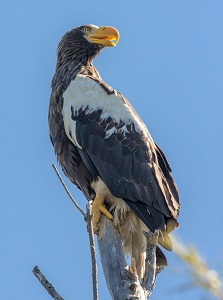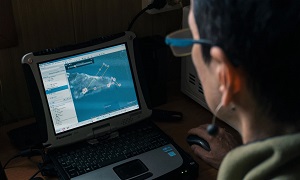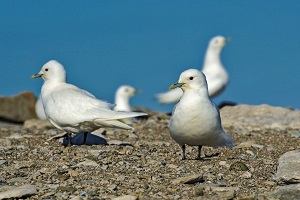Please activate JavaScript in your browser to use all interface options.
Rosneft's environmental projects make a significant contribution to studying and preserving rare bird species
31 March 2023
On April 1, Russia traditionally celebrates the Bird Day. The date is intended to draw attention to the need to preserve the species diversity and numbers of birds in their natural habitat.
Environment protection is an integral part of Rosneft corporate culture and operation principles. The Company is a member of the UN Global Compact for more than 10 years and in 2018 reaffirmed its commitment to 17 UN Sustainable Development Goals.
Rosneft pays considerable attention to the bird protection and studies. The company conducts large-scale scientific research, and its subsidiaries carry out various campaigns and grant programs.
 For example, employees of the Komsomolsk Refinery and specialists of the reserve "Zapovednoe Priamurie" launched a joint environmental project "Under the Strong Wing". The goal of the project is to preserve and restore the population of the red-listed Steller's sea eagle. It is one of the largest birds in the world, and it nests only in the Russian Far East.
For example, employees of the Komsomolsk Refinery and specialists of the reserve "Zapovednoe Priamurie" launched a joint environmental project "Under the Strong Wing". The goal of the project is to preserve and restore the population of the red-listed Steller's sea eagle. It is one of the largest birds in the world, and it nests only in the Russian Far East.
Pollution of eagle nesting territories with household garbage is one of the main factors of population reduction. As part of the project, plant employees cleaned up the area and removed 1.5 tons of trash from eagle nesting sites on the Amur and Gorin rivers. The project "Under the Strong Wing" also includes a rich educational program for pupils of Rosneft-classes and students of relevant specialties of vocational schools and colleges in Komsomolsk-on-Amur.
 RN-Uvatneftegas, together with Tyumen State University, launched a joint grant project that is important for preservation of biodiversity in the Tyumen region. The project is aimed at studying and observing the populations of rare and protected species of birds, which are included in the Red Books of the Tyumen region and Russia. During the 2022 field season, ecologists conducted route surveys in the Irtysh River valley. Specialists recorded visual sightings of birds, their voices and nests. Based on the data obtained, we assessed the quantitative condition of populations and developed a list of measures to reduce the impact on populations of rare species of birds, including biotechnical measures to install artificial nesting sites and pebbles, regulate the number of birds of prey, as well as environmental education for the population.
RN-Uvatneftegas, together with Tyumen State University, launched a joint grant project that is important for preservation of biodiversity in the Tyumen region. The project is aimed at studying and observing the populations of rare and protected species of birds, which are included in the Red Books of the Tyumen region and Russia. During the 2022 field season, ecologists conducted route surveys in the Irtysh River valley. Specialists recorded visual sightings of birds, their voices and nests. Based on the data obtained, we assessed the quantitative condition of populations and developed a list of measures to reduce the impact on populations of rare species of birds, including biotechnical measures to install artificial nesting sites and pebbles, regulate the number of birds of prey, as well as environmental education for the population.
 The most widespread observations of birds are carried out as part of the environmental monitoring of Rosneft's offshore projects. Professional observers, biologists work on geophysical vessels and escort vessels. They collect data on species composition, bird occurrence and migration routes. Scientists report considerable diversity and abundance of birds in the northern seas, especially on ship transits along the mainland coast and islands. Using the data obtained, the Company develops programs for biosphere monitoring during the implementation of offshore projects.
The most widespread observations of birds are carried out as part of the environmental monitoring of Rosneft's offshore projects. Professional observers, biologists work on geophysical vessels and escort vessels. They collect data on species composition, bird occurrence and migration routes. Scientists report considerable diversity and abundance of birds in the northern seas, especially on ship transits along the mainland coast and islands. Using the data obtained, the Company develops programs for biosphere monitoring during the implementation of offshore projects.
Rosneft also conducts research on the population of the Ivory gull, a very rare and small Arctic bird species. Monitoring of this red-listed species is part of a targeted innovation project to assess the sustainability of Arctic ecosystems. The project has been implemented since 2020 as part of the national project "Business and Biodiversity" and the Cooperation Agreement with the Ministry of Natural Resources of Russia.
 The Ivory gull studies are carried out by the Arctic Research Centre (part of the Rosneft Oil Company) with the involvement of specialists from the Arctic and Antarctic Research Institute of St. Petersburg. Islands in the north-east of the Kara Sea are the main nesting area of the Ivory gull colonies in Russia. The company conducted field studies in the area in the summer and fall of 2020 and 2022. Biologists obtained data on the presence and number of Ivory Gull colonies during aerial surveys using photo- and video-recording equipment. Specialists also conducted ringing, tagging and biometric examination of individuals, and collected samples for various biological studies.
The Ivory gull studies are carried out by the Arctic Research Centre (part of the Rosneft Oil Company) with the involvement of specialists from the Arctic and Antarctic Research Institute of St. Petersburg. Islands in the north-east of the Kara Sea are the main nesting area of the Ivory gull colonies in Russia. The company conducted field studies in the area in the summer and fall of 2020 and 2022. Biologists obtained data on the presence and number of Ivory Gull colonies during aerial surveys using photo- and video-recording equipment. Specialists also conducted ringing, tagging and biometric examination of individuals, and collected samples for various biological studies.
Note for Editors:
Steller's sea eagle‑ is one of the largest birds in the world, inhabiting the Far East of Russia: sea coast of Kamchatka, Sakhalin Island, coastline of the Sea of Okhotsk and the lower Amur. This species ‑is endemic to our country, that is, the species does not nest anywhere else.
The eagle genus includes large carnivores, and Steller's sea-eagle is the largest among them. The total body length reaches 110 cm, the wingspan - up to 250 cm, the weight of individual specimens can equal 9 kg.
The eagle is a big bird, and its nests are also large. The newly built nest can reach 1 m across and almost as much in height. However, Steller's sea eagles do not build a new nest every year, they merely adjust it. After a few years, the structure reaches a huge size - up to 3 meters. Such a nest can easily accommodate 2 people.
The Ivory gull is a rare and protected species, the smallest and most endemic species of Arctic seabird with a limited breeding ground. Most of the global population nests in Russia from Spitsbergen eastward to the Laptev Sea. Included in the Red Book of the Russian Federation and the Red List of the International Union for Conservation of Nature.
The Ivory gull lives permanently in the Arctic. It is even referred to as a feathered polar bear, as it is so closely associated with the high latitudes.
The Ivory Gull is a typical seabird and only goes on land during the breeding season. Young and skip-breeding birds stay exclusively at sea and roam widely in the Arctic Ocean waters within the drifting ice zone.
Rosneft
Information Division
March 31, 2023

-315xx70.png)

